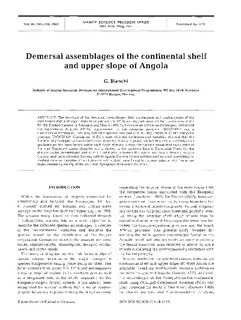| dc.description.abstract | The structure of the demersal assemblages (fish, crustaceans and cephalopods) of the continental shelf and upper slope of Angola (ca 5 to 17-degrees-S) was studied based on the trawl survey of the RV `Dr. Fridtjof Nansen' in February and March 1989, by means ot an ordination technique, Detrended Correspondence Analysis (DCA), implemented by the computer program DECORANA and a classification technique, Two-Way Indicator species Analysis (TWIA), implemented by the computer program TWINSPAN. Correlation of DCA axes with the environmental variables showed that the thermal, depth-dependent stratification explains the main groupings, while bottom type and latitudinal gradients are the main factors within each depth stratum. A major latitudinal faunal shift takes place in the area Tombua-Cunene (Angola) and is related to the southern limit of Equatorial Water for the shallow-water assemblages and to the frontal area between the warm, southward-flowing Angola Current and the northward-flowing cold Benguela Current for the subthermocline shelf assemblages. Highest biomass densities (from bottom trawl catches) were found in correspondence with the upper slope, consisting mainly of the bony fish Synagrops microlepis (Norman). | en |
